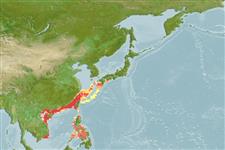Common names from other countries
>
Eupercaria/misc (Various families in series Eupercaria) >
Sparidae (Porgies)
Etymology: Evynnis: Greek, eu = good + Greek, ynnis, -eos = ploughshare (Ref. 45335).
More on author: Lacepède.
Environment: milieu / climate zone / depth range / distribution range
Ecología
marino asociado a arrecife; rango de profundidad 0 - 100 m. Tropical; 35°N - 10°N, 105°E - 135°E
Western Pacific: East and South China seas, and the northern part of the Philippines (Ref. 2115).
Length at first maturity / Tamaño / Peso / Age
Maturity: Lm 11.7 range ? - ? cm
Max length : 40.0 cm TL macho / no sexado; (Ref. 2115); common length : 20.0 cm TL macho / no sexado; (Ref. 2115)
Found over a wide range of bottom types from the surface to 100 m, but is more common close to reefs or on rough bottoms. Small individuals are very common at some localities in shallow, sheltered bays; larger fish often occur in deeper water. Important food fish.
Life cycle and mating behavior
Maturities | Reproducción | Spawnings | Egg(s) | Fecundities | Larva
Masuda, H., K. Amaoka, C. Araga, T. Uyeno and T. Yoshino, 1984. The fishes of the Japanese Archipelago. Vol. 1. Tokai University Press, Tokyo, Japan. 437 p. (text). (Ref. 559)
IUCN Red List Status (Ref. 130435)
CITES (Ref. 128078)
Not Evaluated
Threat to humans
Harmless
Human uses
Pesquerías: comercial
Herramientas
Special reports
Download XML
Fuentes de Internet
Estimates based on models
Preferred temperature (Ref.
115969): 18.5 - 28.4, mean 25.2 (based on 260 cells).
Phylogenetic diversity index (Ref.
82804): PD
50 = 0.6250 [Uniqueness, from 0.5 = low to 2.0 = high].
Bayesian length-weight: a=0.01950 (0.01094 - 0.03474), b=3.00 (2.85 - 3.15), in cm Total Length, based on LWR estimates for this species & (Sub)family-body (Ref.
93245).
Nivel trófico (Ref.
69278): 3.3 ±0.39 se; based on food items.
Resiliencia (Ref.
120179): Medio, población duplicada en un tiempo mínimo de 1.4-4.4 años (Preliminary K or Fecundity.).
Fishing Vulnerability (Ref.
59153): Low to moderate vulnerability (27 of 100).
